What is an egg incubator?
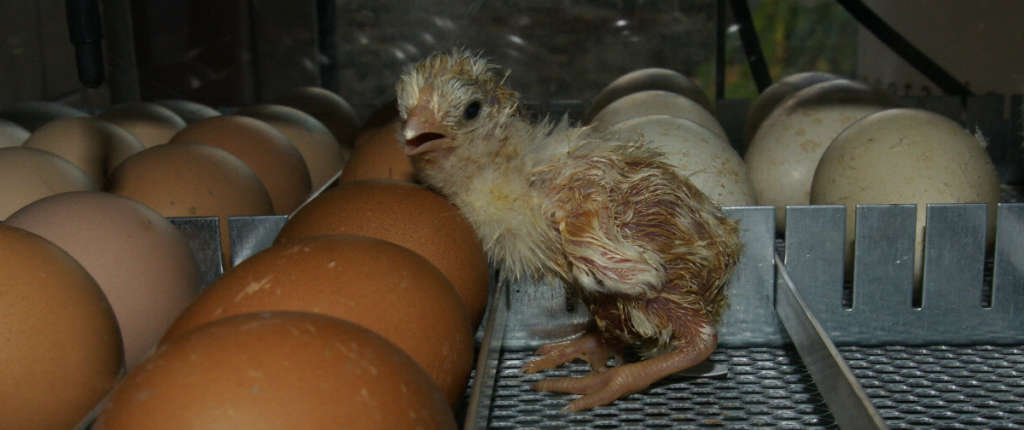
The egg incubator is an insulated warm container for hatching eggs and artificially performs the role that a broody hen does in nature. It can be made of wood, metal or plastic and contains a heating element, a thermostat to maintain an accurate temperature, egg cradles, water troughs for humidity and in some cases a fan and automatic egg roller or turner.
It is a mechanical device which controls temperature to around 100F or 37.7C and humidity creating the ideal conditions which allows the chick to grow inside of a fertilised egg, without need for a broody hen. It enables large numbers of eggs to be incubated in all seasons.
Why use incubators to hatch eggs?
Incubators can hatch more eggs at a time. I have one that can hold 300 eggs so I would need about 25 broody hens a month to hatch the same number of eggs. They are more reliable than the hen.
Below: this is one of my Incubators, it has run non stop for 6 years.

For the backyard chicken keeper wishing to hatch their own they also offer a far more involved way of raising your own chicks. You get to see and have a hand in the whole process from setting the eggs to turning out the flock.
If you let the hen hatch eggs then she will stop laying eggs for the time that she sits on the eggs and rear her offspring. This means that you are loosing many potential chicks that you could've hatched in the incubator. If you continue removing eggs from the hens nest then she will continue laying eggs that you can hatch in the incubator. A hen can hatch about 20 to 30 chicks per year.
You can use them at any time of year, very handy when you have to supply eggs to consumers in the winter season and control of the process is necessary.
How it works:
In the olden days incubators were wooden boxes with a paraffin lamp that heated a water reservoir inside the box and they were surprisingly effective with a little practice. My Grandfather used one successfully up until the late 1950's.
Below: modern incubators have come a long way since this one was sold.
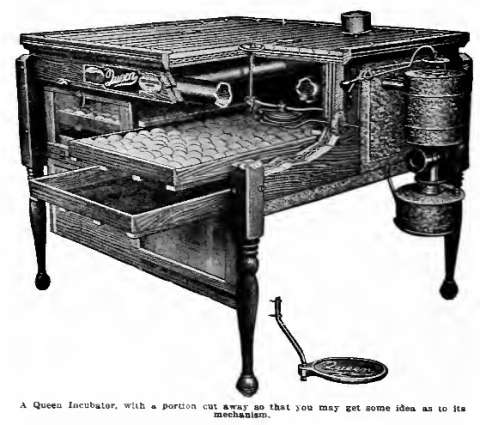
Modern incubators come in two types:
- Forced air or fan assisted or still air.
- Automatic or manual egg turning.
Forced air or fan assisted incubators are built to include a small motor and a fan, often similar to that found in computers which work at keeping a more even temperature inside. This helps prevent cold spots and allows for more accurate temperature control.
Below: Old incubators were heated with a paraffin flame.
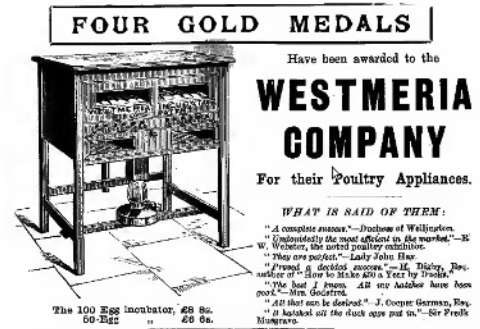
As the inside temperature of the incubator must be kept at a constant level, ideally the incubator should be kept inside and in a room where the temperature will not drop too low.
Eggs need to be turned at least 3 times a day and the mechanism of the incubator will dictate whether this will be done manually by you or automatically by the incubator itself.
Eggs turning is accomplished either with automatic motor driven systems or by simply opening the incubator and turning the eggs by hand. There is a middle ground with a mechanism inside the incubator controlled by a handle on the outside that turns all the eggs at once without having to open the lid.
One of the major advantages of an automatic egg incubator is that it turns the eggs for you, so you don’t have to remember to do so each day. The eggs sit in compartments on a specially designed tray. This tray is moved automatically by a motor which cause the eggs to rotate.
Automatic is preferable as the turn the eggs much more often that you would if you were doing it manually. The eggs are placed on a tray inside the incubator and they need to be turned at least 3 times a day. The smaller the egg the more will fit in the incubator and the larger the egg the fewer will fit.
Water needs be added to the incubator each day to keep the humidity at the correct levels and this level will increase on the last few days of incubation. There is usually a hole at the base of the incubator which allows the water to be added without the need for the incubator to be opened
If you have a good memory and are not stuck at work all day and want to be more involved in the incubation process then a manual incubator is for you.
It is a good idea to always mark one side of the egg even with automatic egg turners so that you can track when they were last turned. It is important that eggs are turned regularly as the chick can stick to the inside of the shell. With marked eggs you can see the egg turning mechanism is still working properly at a glance.
What does an egg incubator do?
An egg incubator creates a stable environment in which eggs can be hatched.
When incubating eggs under a broody hen there are external threats such as wild animals that may harm the hen or the eggs. By placing the eggs in an egg incubator you are more guaranteed that the conditions will remain consistent over the 21 day incubation period.
An egg incubator basically takes the guesswork out of incubation and increases the chances that you will get a consistently good hatch rate.
Which incubators do I use?
I have 4 incubators I use regularly. I liked one of them so much I bought a second and then a third and fourth.

This is the chicktec incubator I have 4 of. The green one has run continuously for 6 years. I don't hatch in it, that way it stays clean and fluff free. It is quiet, efficient and very accurate.
I have a brinsea octagon 40
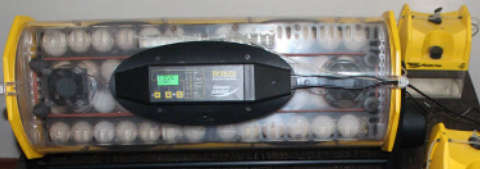
And this is my Rcom 50 which is a really nice top of the range incubator but is eye wateringly expensive.
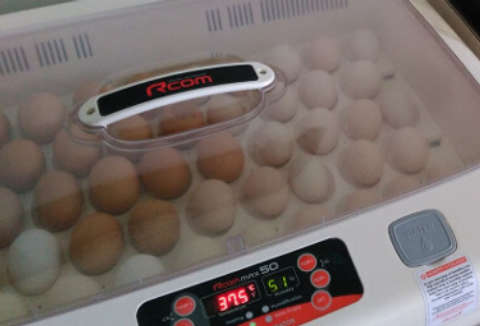
The featured image at the top of this article is my Maino 77. It is however quite noisy.
I have used many of the cheaper Chinese imposts over the years but the egg turned are unreliable and the elements liable to fail. They are difficult to use and not really well insulated.
What is an egg setter?
I make use of a setter and hatcher for my incubation. It enables me to keep the incubators clean and free of fluff.
A setter is used for the first 18 days of incubation and is more commonly used commercially when eggs are transferred to a hatcher, see below, for the final stages.
For chicken eggs the first 18 days of the eggs incubation period the eggs must be placed in the setter. In backyard chicken keeping when using small domestic incubators the setting and hatching happens in the same machine.
Eggs are turned by the incubator every hour in the setter. After the setting period eggs are physically moved to the hatcher, where they will hatch on day 21.
What is an egg hatcher?
The hatcher is either a space in the bottom of the incubator or a totally separate space where the where the eggs lay still for the last 3 days the cycle. Generally the humidity and airflow is slightly higher and the temperature a degree lower in this part of the incubator.
Below: This is my hatcher. It holds up to 80 eggs at a time. It is just an easy to clean incubator. Here with wyandottte chicks.
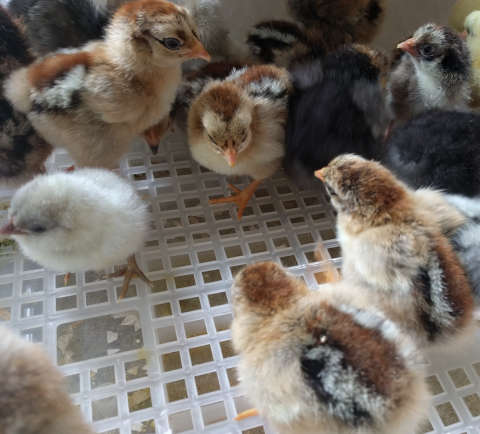
The hatcher creates a stable environment for the eggs to hatch in and no turning of the eggs happens during this phase. The chick aligns itself so that it can pip the shell and then hatch.
Large operations use separate setters and hatchers and they are especially common in the turkey industry when you need to produce large quantities of birds quickly for the all to be ready in time for traditional feasts like Thanksgiving or Christmas.
History of the incubator:
The Egyptians had methods of incubating in 400 B.C., using a cylindrical building that had a fire at the bottom. The eggs that were incubating were placed on an inverted cone that was partially covered in ash. The people managing the process used to test the temperature of the eggs by holding them against a closed eye. The eggs were placed in a woven basket that sat on top of the ashes.
Réaumur used the newly discovered accurate alcohol-based thermometer in his design for an artificial incubator, presented to the Académie des sciences in 1747, and published in 1749 as "l’Art de faire éclore et d'élever en toute saison des oiseaux domestiques de toutes espèces, soit par le moyen de la chaleur du fumier, soit par le moyen de celle du feu ordinaire" or "the art of hatching and rearing domestic birds of all species in all seasons, either by means of the heat of manure or by means of ordinary fire".
Lyman Byce created a coal lamp incubator in 1879. The first commercial machine was made by Hearson in the year of 1881.
Incubators became available to the backyard and hobby keeper from the late 1890's but were expensive, temperamental and difficult to use as they tended to rely on a paraffin lamp.
Modern Electric powered incubators have been around since the 1960's although they have been and are quite expensive.
How safe is the egg incubator?
Modern brand name incubators are as a rule safe.
They have to comply with safety standards and will be tested to whatever standards your country requires. This means they will have to meet certain flammability criteria and have safety measures in place that prevent overheating and shut down if faults are detected.
The rule for safe incubation is buy a quality reputable machine and follow the care and cleaning instructions.
A few years ago the BBC did a program about incubators causing fire. It seems the cheap imports are not subject to the same quality controls and were causing fires.
I have had several cheap Chinese incubators off eBay and the like over the years and they never last. they cannot cope with the humidity and rust quickly.
Other common names for incubators:
The common names of the incubator in other terms include breeding machines, hatching machines, hatchers, setters, artificial incubation equipment, hatcheries, egg breeding equipment, egg hatching equipment, broedmasjiene, and bators.
